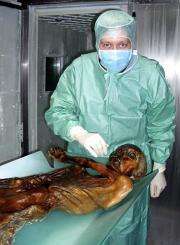Oetzi, the Iceman, was ceremonially buried: archaeologist

Oetzi, the 5,300-year-old "Iceman", may not have died at the site in the Italian Alps where he was found 19 years ago, but was only ceremonially buried there, according to a new theory revealed on Thursday.
Until now, archaeologists thought Oetzi, whose mummified corpse was discovered in a high mountain pass in the Oetztal Alps in 1991, died at that spot from wounds he had sustained in a fight.
But Alessandro Vanzetti from Rome University told the Austrian daily Die Presse he believes the Bronze Age warrior actually died much nearer sea-level, but was then buried months later with full ceremonial honours high up in the mountains.
Vanzetti and his team have been investigating the site at 3,210 metres (10,500 feet) above sea-level for the past five years.
The new theory would explain why some of the weapons discovered alongside the mummy were not ready for use and why so many objects were found next to the body, Vanzetti told the newspaper.
Some of the objects were valuable and would surely have been looted by his murderer if Oetzi had died in a fight at the spot where he was found, the archaeologist continued.
Furthermore, an analysis of his stomach contents had shown that the man died in April, while pollen found at the site indicated the body was buried in August or September.
By that time, the ice would have melted, making an ascent to such a height possible, the archaeologist continued.
(c) 2010 AFP















